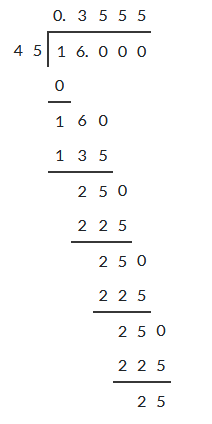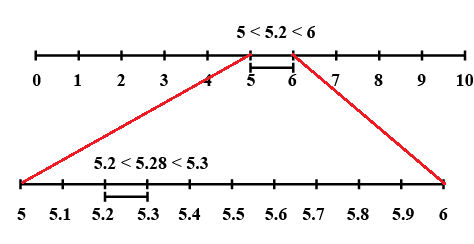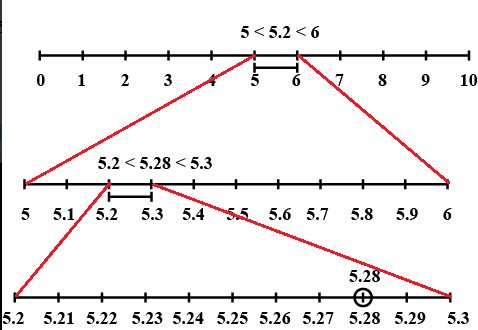 | e-NOTES (1060 [C] ) | ||
| 9th (Maths) | |||
| Number System II | |||
Converting Non Terminating Repeating Decimals into FractionsNon Terminating Repeating Decimals:The rational numbers which when expressed in decimal form by division method, no matter how long they are divided, they always leave a remainder . In other words, the division process never comes to an end. This is due to the reason that in the division process the remainder starts repeating after a certain number of steps. In such cases, a digit or a block of digits repeats itself.For example, 0.3333...,0.1666666....,0.123123123....,1.2692307692307692307.... etc. Such decimals are called non-terminating repeating or recurring decimals. These decimal numbers are represented by putting a bar over the first block of the repeating part and omit the other repeating blocks. Thus, we write
Illustration: Find the decimal representation of Solution: By long division, we have
Hence, Converting Non Terminating Repeating Decimals into Fractions:In a non-terminating repeating decimal, there are two types of decimal representation. (i) A decimal in which all the digits after the decimal point are repeated. These types of decimals are known as pure recurring decimals. For example: (ii) A decimal in which at least one of the digits after the decimal point is not repeated and then some digit or digits are repeated.This type of decimals are known as mixed recurring decimals. For example Conversion of a Pure Recurring Decimal to the Form:In order to convert a pure recurring decimal to the form Step 1 Obtain the repeating decimal and put it equal to x (say). Step 2: Write the number in decimal form by removing bar from the top of repeating digits and listing repeating digits at least twice. For example, write Step 3: Determine the number of digits having bar on their heads. Step 4: If the repeating decimal has 1 place repetition, multiply by 10 for a two place repetition, multiply by 100 and for a three place repetition, multiply by 1000 and so on. Step 5: Subtract the number in step 2I from the number obtained in step 4 Step 6: Divide both sides of the equation by the coefficient of x. Step 7: Write the rational number in its simplest form. The following examples will illustrate the above procedure. Illustration : Express of the following decimals in the form
Solution: (i) Let x = 0.11111... ........[1] As only one digit is repeating multiply both sides with 10
On subtracting (1) from (2) , we get 9x = 1 (ii) Let x = 0.222222.....
On subtracting (i) from (ii), we get 9x = 2 (iii) Let x = 0.33333......
On subtracting (i) from (ii) , we get 9x = 3 Proceeeding as above, we obtain Also, we have and, REMARK It follows from the above example that Conversion of a Mixed Recurring Decimal to the Form
While converting a recurring decimal that has one or more digits before the repeating digits, it is necessary to isolate the repeating digits. In order to convert a mixed recurring decimal to the form Step 1: Obtain the mixed recurring decimal and write it equal to x(say). Step 2: Determine the number of digits after the decimal point which do not have bar on them. Let there be n digits without bar just after the decimal point. Step 3: Multiply both sides of x by Step 4: Use the method of converting pure recurring decimal to the form Illustration: Express Solution: Let x = As there is only one digit after the decimal point which do not have bar so multiply both sides with 10 10x = 157.121212.... .......[1] As two digits are repeating multiply both sides with 100
On subtracting (1) from (2) , we get 990x = 15555 | |||
Number Line using Successive MagnificationWe know that on a number line between any two points infinite number of point exist. So any number can be plotted on the number line by magnifying the line between two points, Number Line using Successive Magnification:To visualize the position (or representation) of numbers in decimal form the steps are 1. Analyse the given number and find the two points between which the number will lie. 2. Magnify the line between these two points.and find points with one decimal point between which the number will lie. 3. Repeat the step 2 for each decimal point. This process of visualization of numbers on the number line, through a magnifying glass, is known as the process of successive magnification. Illustration: To visualize the representation of 5.28 on the number line. Solution:We observe that 5.28 lies between 5 and 6. So, let us look closely at the position of the number line between 5 and 6.
We divide this portion into 10 equal parts and mark each point of division as shown in figure below This first mark to the right of 5 will represent 5.1, the second 5.2 and so on. To see this clearly, we magnify this portion by taking magnifying glass and look at the portion between 5 and 6. Through magnifying glass this portion between 5 and 6. As. 5.28 lies between 5.2 and 5.3. So, let us mark 5.2 and 5.3 and magnify the portion between them
We will again divide this portion into 10 equal parts and mark each point of division as shown in figure below This first mark to the right of 5.2 will represent 5.21, the second 5.22 and so on. To see this clearly, we magnify this portion by taking magnifying glass and look at the portion between 5.2 and 5.3 . The required point is 5.28
This process of visualization of numbers on the number line, through a magnifying glass, is known as the process of successive magnification. | |||
Plotting any Irrational Numbers On a Number LinePlotting any Irrational Numebrs On a Number Line: For any positiv real number x, we have Therefore, to find the positive square root of a positive real number, we may follow the following algorithm. ALGORITHM: STEP I Obtain the positive real number x(say) STEP II Draw a line and mark a point A on it. STEP III Mark a point B on the line such that AB = x units. STEP IV From point B mark a distance of 1 unit and mark the new poiint as C. STEP V Find the mid-point of AC and mark the point as O. STEP VI Draw a circle with centre O and radius OC> STEP VII Draw a line perpendicular to AC passing through B and intersecting the semi-circle at D. Length BD is equal to Justification: We have, AB = x units and BC = 1 unit.
Now, Using Pythagoras Theorem in This shows that In order to find the position of Now, draw an arc with centre at B and radius equal to BD. Suppose this arc cuts the number line BC with B as the origin at E. Then, BE =
| |||
RationalizationRATIONALIZATION: Let a and be positive real numbers.Then, Rationalisation of Denominator: Sometimes we come across expressions containing square roots in their denominators. Addition, subtraction, multiplication and division of such expressions in convenient if their denominators are free from square roots.To make the denominators free from square roots, we multiply the numerator and denominator by an irrational number. Such a number is called rationalisation factor. Consider the expression We know that
Let us now consider the expression We know that
So, we multiply the numerator and denominator by Example: If SOLUTION We have,
Now,
| |||
 | |||

Powered by ABHYAS ChatBOT.

What describes you best?

I am a Student
I am a Tutor
I am a School Owner
I want to appear for Govt. Exams




